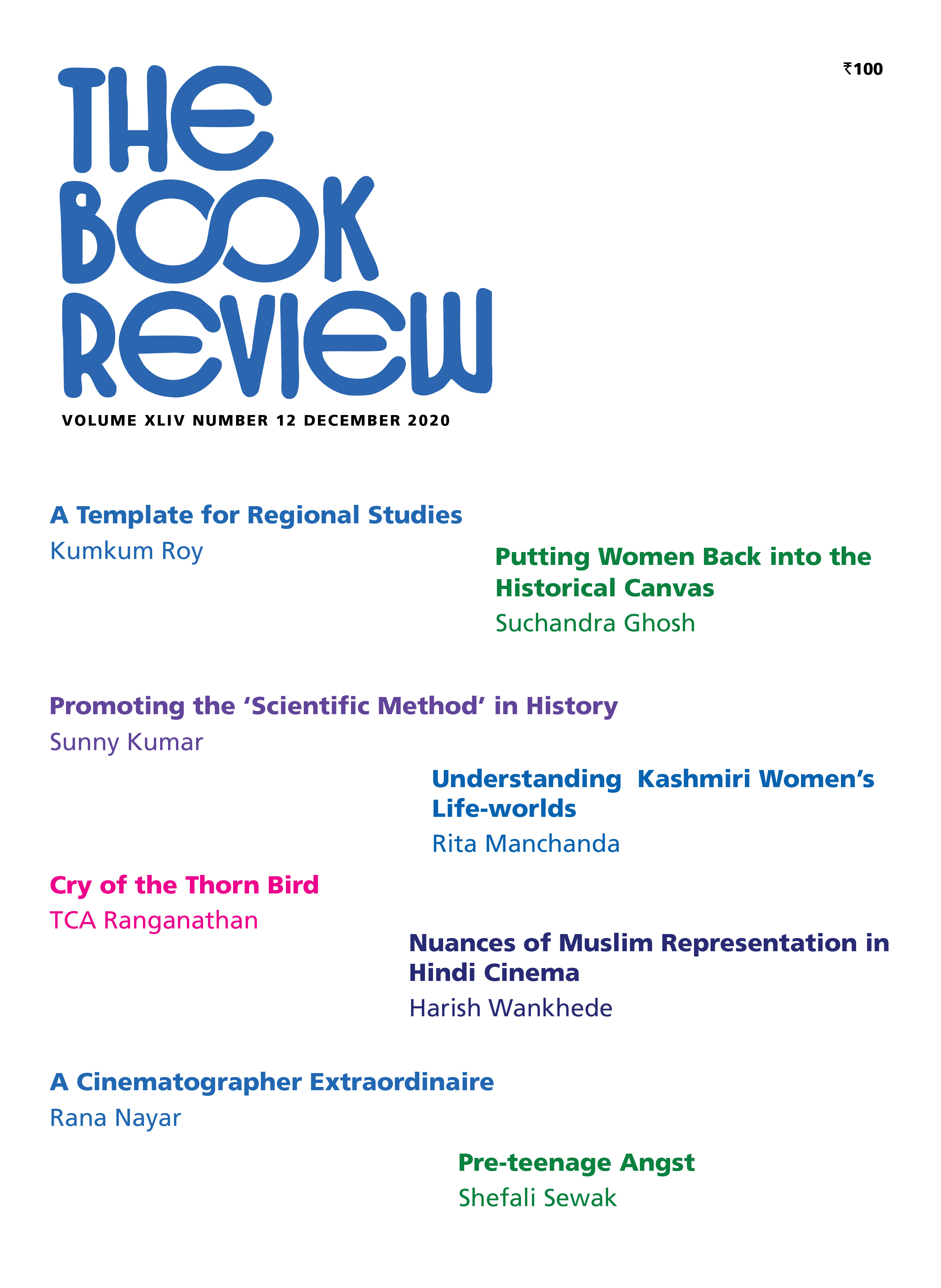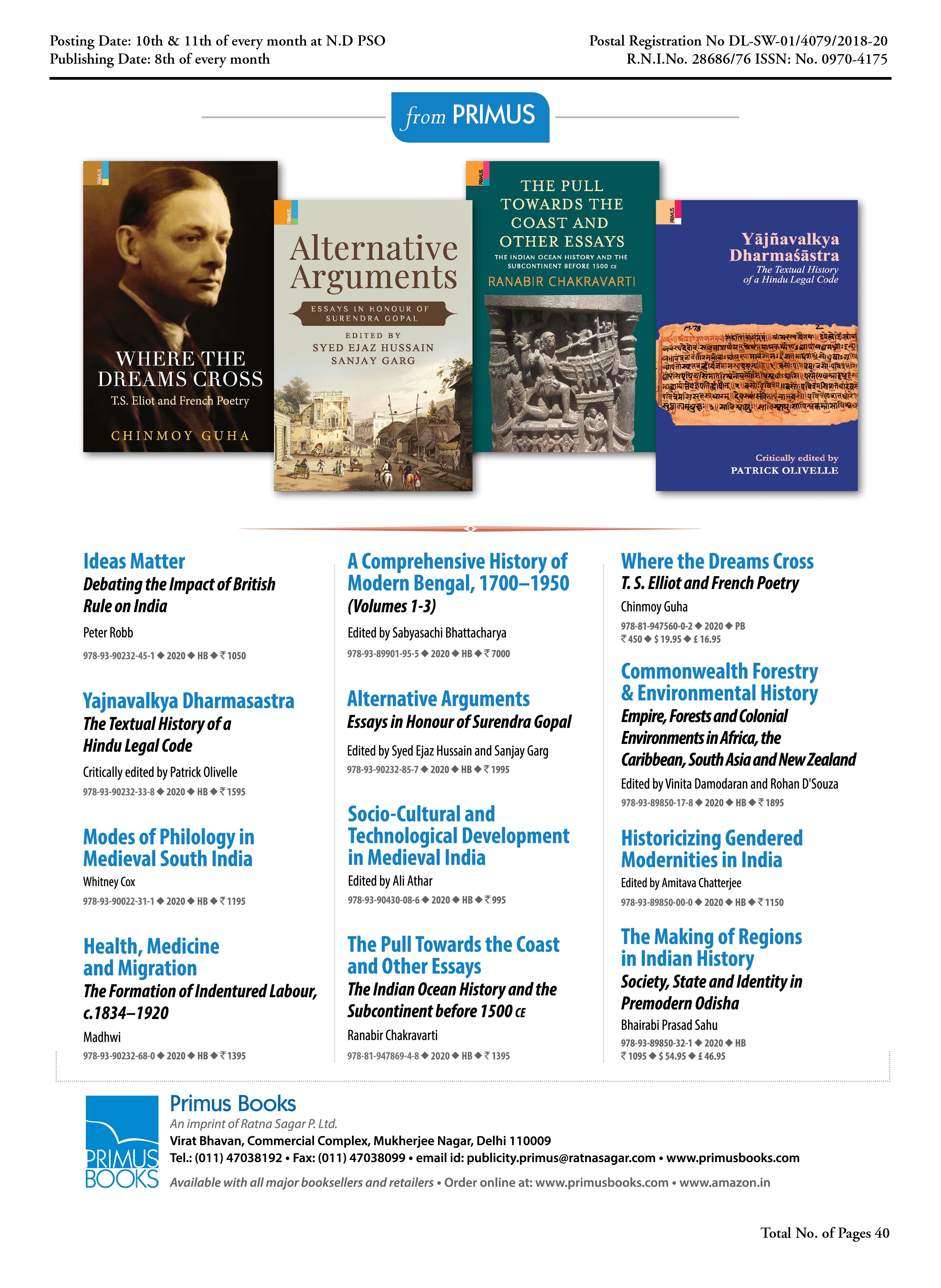Part of an encyclopaedic project on the history of an important region in the eastern part of the subcontinent, the volumes under consideration focus on the ancient and early medieval periods. The first and longer volume is more heterogenous, while the second is more sharply focused.
CURRENT ISSUE
VOLUME XLIV NUMBER 12 DECEMBER 2020
Among the many voices of history in early India, women were marginal and their voices were almost unheard. Fortunately with the continuous efforts of a few historians (Sukumari Bhattacharji, Uma Chakravarti, Kumkum Roy, Vijaya Ramaswami and others), largely since the 1980s.
What could be a better testimony to the perennial appeal of India’s epics than the fresh retellings and translations being published at fairly regular intervals? Each generation appears to need its own version in language that it can relate to. Now Uberoi’s 1996.
The work under review is the thirty-first volume in the People’s History of India textbook series edited by its author Irfan Habib himself. The publisher’s intention behind this series is the promotion of ‘scientific method in History, and resisting communal.
Yogendra Yadav’s voice has a familiar, unruffled and calm quality to it even as it has pronounced on the turbulent ructions of Indian politics. That same calm, unruffled quality can be heard speaking through these many pages of this voluminous book that combines more..
One of the casualties of the perennial India-Pakistan face-off is an academic understanding of the other side. The kind of first-hand sense of a locale that can be obtained over many field trips is denied to Indian academics with Pakistan as subject of scrutiny.
Madrasas in the Age of Islamophobia</em> by Zia Us Salam and M Aslam Parvaiz offers us an insight into the different facets of the world of madrasas in India. The preface spells out the central question/intent: what the reality of madrasas is today, a ubiquitous part of the landscape.
The ideational cohesion holding together this compelling collection of essays is driven by the need to visibilize the particularity of Kashmiri women’s ‘own ways of knowing’. The title <em>Can You Hear Kashmiri Women Speak? Narratives of Resistance and Resilience.
What exactly does an ambassador or a career diplomat do? Is it merely enjoying a comfortable life, mouthing high sounding ideals and engaging in protocol and immigration issues? How much scope is there for individual initiatives to play out? Reading through this autobiography.
Urjit Patel joined the Reserve Bank of India as Deputy Governor in January 2013 in charge of the Monetary Policy Department and was subsequently elevated as the 24th Governor of the RBI from September 2016 as the successor to Dr. Raghuram Rajan. He left rather prematurely on 10th December 2018.
The book is a collection of relevant works on different regulatory institutions in India. Given the paucity of literature on state regulation, the essays offer an in-depth view of how different regulatory institutions in India have responded to streamline the administration of the economy.
Rethinking the Social Sciences with Sam Moyo </em>is a tribute to one of Africa’s and Zimbabwe’s greatest modern thinker, Sam Moyo, who made an astounding contribution to social science with his intellectual work on the land and agrarian questions of the global South.
Rethinking Social Justice </em>was published earlier this year in honour of MSS Pandian, the late historian of South India. The volume comprises an array of essays on a wide range of topics that are thematically organized into five sections: ‘Politics of Culture.
For the last hundred years, Ambedkarite politics has been imperatively speaking to the people of India about the idea of constitutionalism. In 1919, while submitting a memorandum to the South Borough Commission on behalf of the Depressed Classes.
Women constitute a significant composition of Indian diasporic communities universally. Even though the role of female sojourners has been invisible in diasporic accounts for considerable period of time, feminist and subaltern interventions made substantial advancement.
The ‘exceptionalism’ of the book under review according to its author, a senior journalist, lies in the fact that it seeks to unravel the rise of the Modi leadership ‘from the middle class perspective’ without adhering to ‘any ideological point of view’ unlike ‘other books.
Tribal societies are marked by contestation, competition, movement, conflict, etc., in the contemporary period. These concerns are mainly revolving around the question of livelihood and survival of tribal communities. Their livelihood and survival largely depend.
The Covid-19 global pandemic has changed the way of life for one and all across the planet, and the battle against the virus is still ongoing. Many books about Covid-19 have been published since the virus first emerged in Wuhan, China, addressing various aspects of it.
Representation is a tricky word as there can never be an authentic representation. Any act of representation conceals a lot and only offers a timid glimpse of reality. Cinema is well known for such deception. It often claims to be a reflexive comrade that would showcase.
More than a cinematographer extraordinaire, Shyam Benegal is a phenomenon, an institution of sorts. So strong is his influence on the parallel or new cinema of contemporary times that one may easily speak of the Benegal school of film-making. It is another matter.
The three plays, introduced with a skilled and analytically detailed discussion, rise above parochialisms of time, space, culture and language. They resonate with universal themes and emotions like love, duty, guilt and the sheer tedium of existence that saps one’s soul of vibrancy and one’s life of joy.
This novel is really a chronicle, like Malory’s Le Morte d’Arthur, of a time, and characters who lived in that time, kings, nobles, knights and wizards; what happened to them, the events of which they were part, and how they survived or were destroyed. But that’s where any resemblance fades.
Benyamin’s latest novel in English, Body and Blood, unravels a new kind of politics that interweaves faith and crime as the author deals with the influence of religious dogmatism in the lives of faithful believers. The setting of the novel spreads over a group of Indian cities and the narrative is shaped.
Lockdown. Isolation. Social distancing. Cases. PPE. These are but fragments of the vocabulary that have entered our lives with the onset of the pandemic. Now that ‘the new normal’ has been set and the countless deaths slowly become cold numbers that we scroll past on .
Each an eight page fold out hard-board book, this set of four books, Peek-a-Book by Kaori Takahashi has been very well conceptualized and designed. One of the books deals with a friend’s birthday and is called Birthday Surprise. As you unfold the sturdy hard-board colourfully illustrated pages.
Given that the picture on the book cover of Why is My Hair Curly? is of a curly-haired girl in reverie holding a pen with a journal in her hand, coupled with the title, one might anticipate the book to be about a young girl’s travails of managing curly hair. One would be wrong.
First Prize (Rs.10000): Megalomania, by JoBeth Ann Warjri
Second Prize (Rs.7500): Not A Day For Outings, by Armaan
Third Prize (Rs.5000): Her Day, by Santanu Das
Congratulations!
We will be reaching out to the winners individually.
We would like to thank all participants for an overwhelming and enthusiastic response.































